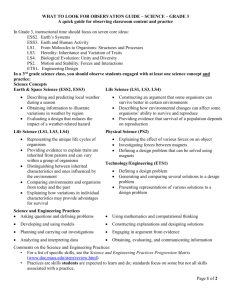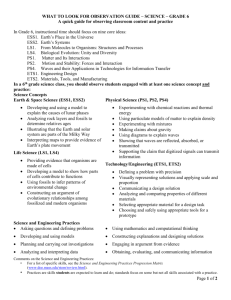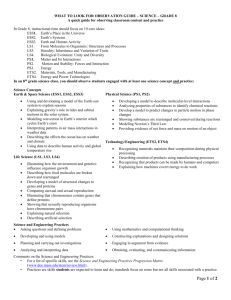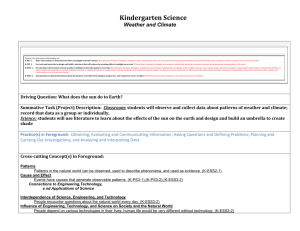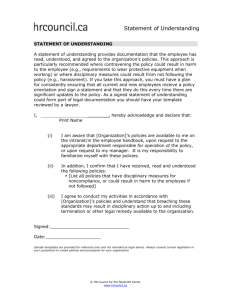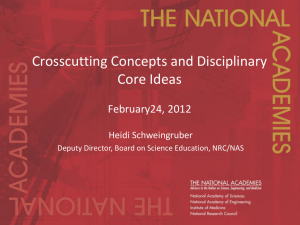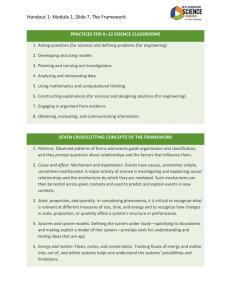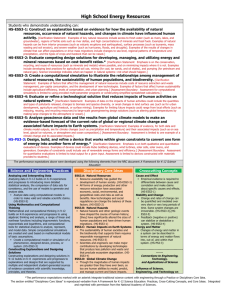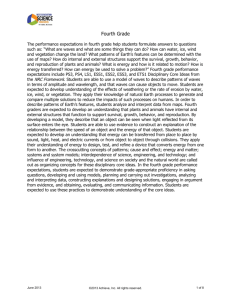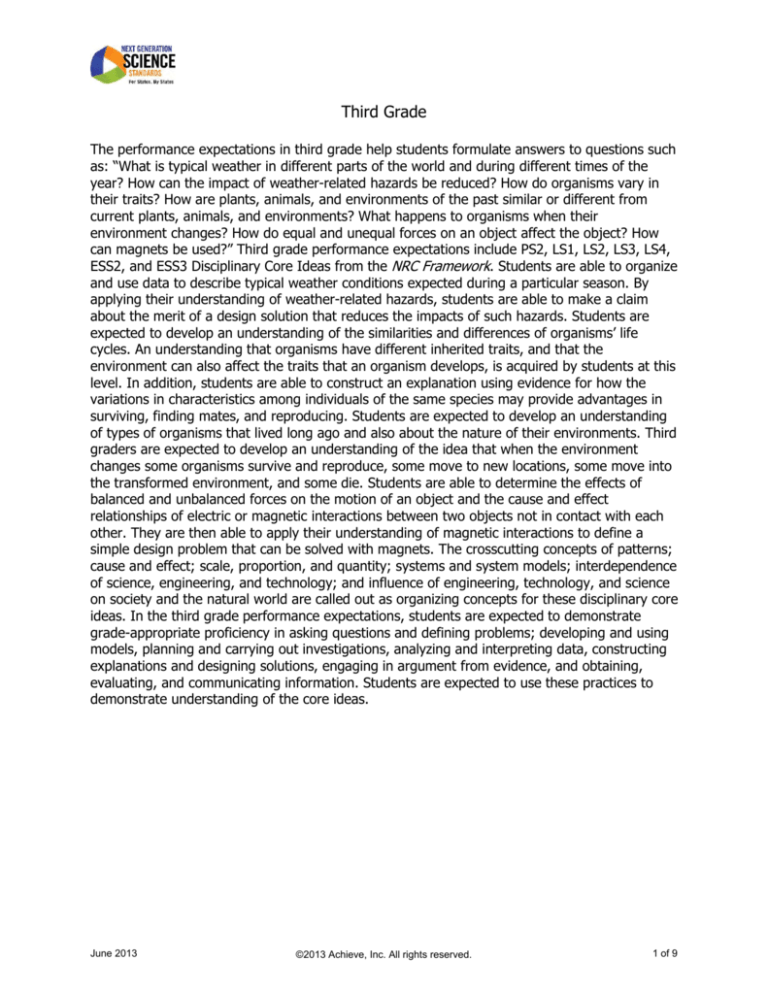
Third Grade
The performance expectations in third grade help students formulate answers to questions such
as: “What is typical weather in different parts of the world and during different times of the
year? How can the impact of weather-related hazards be reduced? How do organisms vary in
their traits? How are plants, animals, and environments of the past similar or different from
current plants, animals, and environments? What happens to organisms when their
environment changes? How do equal and unequal forces on an object affect the object? How
can magnets be used?” Third grade performance expectations include PS2, LS1, LS2, LS3, LS4,
ESS2, and ESS3 Disciplinary Core Ideas from the NRC Framework. Students are able to organize
and use data to describe typical weather conditions expected during a particular season. By
applying their understanding of weather-related hazards, students are able to make a claim
about the merit of a design solution that reduces the impacts of such hazards. Students are
expected to develop an understanding of the similarities and differences of organisms’ life
cycles. An understanding that organisms have different inherited traits, and that the
environment can also affect the traits that an organism develops, is acquired by students at this
level. In addition, students are able to construct an explanation using evidence for how the
variations in characteristics among individuals of the same species may provide advantages in
surviving, finding mates, and reproducing. Students are expected to develop an understanding
of types of organisms that lived long ago and also about the nature of their environments. Third
graders are expected to develop an understanding of the idea that when the environment
changes some organisms survive and reproduce, some move to new locations, some move into
the transformed environment, and some die. Students are able to determine the effects of
balanced and unbalanced forces on the motion of an object and the cause and effect
relationships of electric or magnetic interactions between two objects not in contact with each
other. They are then able to apply their understanding of magnetic interactions to define a
simple design problem that can be solved with magnets. The crosscutting concepts of patterns;
cause and effect; scale, proportion, and quantity; systems and system models; interdependence
of science, engineering, and technology; and influence of engineering, technology, and science
on society and the natural world are called out as organizing concepts for these disciplinary core
ideas. In the third grade performance expectations, students are expected to demonstrate
grade-appropriate proficiency in asking questions and defining problems; developing and using
models, planning and carrying out investigations, analyzing and interpreting data, constructing
explanations and designing solutions, engaging in argument from evidence, and obtaining,
evaluating, and communicating information. Students are expected to use these practices to
demonstrate understanding of the core ideas.
June 2013
©2013 Achieve, Inc. All rights reserved.
1 of 9
3-PS2 Motion and Stability: Forces and Interactions
3-PS2
Motion and Stability: Forces and Interactions
Students who demonstrate understanding can:
3-PS2-1. Plan and conduct an investigation to provide evidence of the effects of balanced and unbalanced forces on the
motion of an object. [Clarification Statement: Examples could include an unbalanced force on one side of a ball can make it start moving; and, balanced
3-PS2-2.
forces pushing on a box from both sides will not produce any motion at all.] [Assessment Boundary: Assessment is limited to one variable at a time: number, size,
or direction of forces. Assessment does not include quantitative force size, only qualitative and relative. Assessment is limited to gravity being addressed as a force
that pulls objects down.]
Make observations and/or measurements of an object’s motion to provide evidence that a pattern can be used to
predict future motion. [Clarification Statement: Examples of motion with a predictable pattern could include a child swinging in a swing, a ball rolling
back and forth in a bowl, and two children on a see-saw.] [Assessment Boundary: Assessment does not include technical terms such as period and frequency.]
3-PS2-3.
3-PS2-4.
Ask questions to determine cause and effect relationships of electric or magnetic interactions between two
objects not in contact with each other. [Clarification Statement: Examples of an electric force could include the force on hair from an electrically
charged balloon and the electrical forces between a charged rod and pieces of paper; examples of a magnetic force could include the force between two permanent
magnets, the force between an electromagnet and steel paperclips, and the force exerted by one magnet versus the force exerted by two magnets. Examples of
cause and effect relationships could include how the distance between objects affects strength of the force and how the orientation of magnets affects the direction
of the magnetic force.] [Assessment Boundary: Assessment is limited to forces produced by objects that can be manipulated by students, and electrical interactions
are limited to static electricity.]
Define a simple design problem that can be solved by applying scientific ideas about magnets.*
[Clarification Statement:
Examples of problems could include constructing a latch to keep a door shut and creating a device to keep two moving objects from touching each other.]
The performance expectations above were developed using the following elements from the NRC document A Framework for K-12 Science Education:
Science and Engineering Practices
Asking Questions and Defining Problems
Asking questions and defining problems in grades 3–5 builds on
grades K–2 experiences and progresses to specifying qualitative
relationships.
Ask questions that can be investigated based on patterns
such as cause and effect relationships. (3-PS2-3)
Define a simple problem that can be solved through the
development of a new or improved object or tool. (3-PS2-4)
Planning and Carrying Out Investigations
Planning and carrying out investigations to answer questions or
test solutions to problems in 3–5 builds on K–2 experiences and
progresses to include investigations that control variables and
provide evidence to support explanations or design solutions.
Plan and conduct an investigation collaboratively to produce
data to serve as the basis for evidence, using fair tests in
which variables are controlled and the number of trials
considered. (3-PS2-1)
Make observations and/or measurements to produce data to
serve as the basis for evidence for an explanation of a
phenomenon or test a design solution. (3-PS2-2)
------------------------------------------------
Connections to Nature of Science
Disciplinary Core Ideas
PS2.A: Forces and Motion
Each force acts on one particular object and has both
strength and a direction. An object at rest typically has
multiple forces acting on it, but they add to give zero
net force on the object. Forces that do not sum to zero
can cause changes in the object’s speed or direction of
motion. (Boundary: Qualitative and conceptual, but not
quantitative addition of forces are used at this level.)
(3-PS2-1)
The patterns of an object’s motion in various situations
can be observed and measured; when that past motion
exhibits a regular pattern, future motion can be
predicted from it. (Boundary: Technical terms, such as
magnitude, velocity, momentum, and vector quantity,
are not introduced at this level, but the concept that
some quantities need both size and direction to be
described is developed.) (3-PS2-2)
PS2.B: Types of Interactions
Objects in contact exert forces on each other. (3-PS2-1)
Electric, and magnetic forces between a pair of objects
do not require that the objects be in contact. The sizes
of the forces in each situation depend on the properties
of the objects and their distances apart and, for forces
between two magnets, on their orientation relative to
each other. (3-PS2-3),(3-PS2-4)
Crosscutting Concepts
Patterns
Patterns of change can be used to make
predictions. (3-PS2-2)
Cause and Effect
Cause and effect relationships are routinely
identified. (3-PS2-1)
Cause and effect relationships are routinely
identified, tested, and used to explain
change. (3-PS2-3)
------------------------------------------------
Connections to Engineering, Technology,
and Applications of Science
Interdependence of Science, Engineering,
and Technology
Scientific discoveries about the natural world
can often lead to new and improved
technologies, which are developed through
the engineering design process. (3-PS2-4)
Science Knowledge is Based on Empirical Evidence
Science findings are based on recognizing patterns. (3-PS2-2)
Scientific Investigations Use a Variety of Methods
Science investigations use a variety of methods, tools, and
techniques. (3-PS2-1)
Connections to other DCIs in third grade: N/A
Articulation of DCIs across grade-levels: K.PS2.A (3-PS2-1); K.PS2.B (3-PS2-1); K.PS3.C (3-PS2-1); K.ETS1.A (3-PS2-4); 1.ESS1.A (3-PS2-2); 4.PS4.A (3-PS2-2); 4.ETS1.A (3PS2-4); 5.PS2.B (3-PS2-1); MS.PS2.A (3-PS2-1),(3-PS2-2); MS.PS2.B (3-PS2-3),(3-PS2-4); MS.ESS1.B (3-PS2-1),(3-PS2-2); MS.ESS2.C (3-PS2-1)
Common Core State Standards Connections:
ELA/Literacy –
RI.3.1
RI.3.3
RI.3.8
W.3.7
W.3.8
SL.3.3
Mathematics –
MP.2
MP.5
3.MD.A.2
Ask and answer questions to demonstrate understanding of a text, referring explicitly to the text as the basis for the answers. (3-PS2-1),(3-PS2-3)
Describe the relationship between a series of historical events, scientific ideas or concepts, or steps in technical procedures in a text, using language that pertains to
time, sequence, and cause/effect. (3-PS2-3)
Describe the logical connection between particular sentences and paragraphs in a text (e.g., comparison, cause/effect, first/second/third in a sequence). (3-PS2-3)
Conduct short research projects that build knowledge about a topic. (3-PS2-1),(3-PS2-2)
Recall information from experiences or gather information from print and digital sources; take brief notes on sources and sort evidence into provided categories. (3-PS21),(3-PS2-2)
Ask and answer questions about information from a speaker, offering appropriate elaboration and detail. (3-PS2-3)
Reason abstractly and quantitatively. (3-PS2-1)
Use appropriate tools strategically. (3-PS2-1)
Measure and estimate liquid volumes and masses of objects using standard units of grams (g), kilograms (kg), and liters (l). Add, subtract, multiply, or divide to solve
one-step word problems involving masses or volumes that are given in the same units, e.g., by using drawings (such as a beaker with a measurement scale) to represent
the problem. (3-PS2-1)
*The performance expectations marked with an asterisk integrate traditional science content with engineering through a Practice or Disciplinary Core Idea.
The section entitled “Disciplinary Core Ideas” is reproduced verbatim from A Framework for K-12 Science Education: Practices, Cross-Cutting Concepts, and Core Ideas. Integrated
and reprinted with permission from the National Academy of Sciences.
June 2013
©2013 Achieve, Inc. All rights reserved.
2 of 9
3-LS1 From Molecules to Organisms: Structures and Processes
3-LS1 From Molecules to Organisms: Structures and Processes
Students who demonstrate understanding can:
3-LS1-1. Develop models to describe that organisms have unique and diverse life cycles but all have in common birth,
growth, reproduction, and death. [Clarification Statement: Changes organisms go through during their life form a pattern.] [Assessment Boundary:
Assessment of plant life cycles is limited to those of flowering plants. Assessment does not include details of human reproduction.]
The performance expectations above were developed using the following elements from the NRC document A Framework for K-12 Science Education:
Science and Engineering Practices
Developing and Using Models
Modeling in 3–5 builds on K–2 experiences and progresses to
building and revising simple models and using models to
represent events and design solutions.
Develop models to describe phenomena. (3-LS1-1)
Disciplinary Core Ideas
Crosscutting Concepts
LS1.B: Growth and Development of Organisms
Reproduction is essential to the continued existence of every
kind of organism. Plants and animals have unique and diverse
life cycles. (3-LS1-1)
Patterns
Patterns of change can be used to make
predictions. (3-LS1-1)
----------------------------------------------------------
Connections to Nature of Science
Scientific Knowledge is Based on Empirical Evidence
Science findings are based on recognizing patterns. (3-LS1-1)
Connections to other DCIs in third grade: N/A
Articulation of DCIs across grade-levels: MS.LS1.B (3-LS1-1)
Common Core State Standards Connections:
ELA/Literacy –
RI.3.7
SL.3.5
Mathematics –
MP.4
3.NBT
3.NF
Use information gained from illustrations (e.g., maps, photographs) and the words in a text to demonstrate understanding of the text (e.g., where, when, why, and how
key events occur). (3-LS1-1)
Create engaging audio recordings of stories or poems that demonstrate fluid reading at an understandable pace; add visual displays when appropriate to emphasize or
enhance certain facts or details. (3-LS1-1)
Model with mathematics. (3-LS1-1)
Number and Operations in Base Ten (3-LS1-1)
Number and Operations—Fractions (3-LS1-1)
*The performance expectations marked with an asterisk integrate traditional science content with engineering through a Practice or Disciplinary Core Idea.
The section entitled “Disciplinary Core Ideas” is reproduced verbatim from A Framework for K-12 Science Education: Practices, Cross-Cutting Concepts, and Core Ideas. Integrated
and reprinted with permission from the National Academy of Sciences.
June 2013
©2013 Achieve, Inc. All rights reserved.
3 of 9
3-LS2 Ecosystems: Interactions, Energy, and Dynamics
3-LS2 Ecosystems: Interactions, Energy, and Dynamics
Students who demonstrate understanding can:
3-LS2-1. Construct an argument that some animals form groups that help members survive.
The performance expectations above were developed using the following elements from the NRC document A Framework for K-12 Science Education:
Science and Engineering Practices
Disciplinary Core Ideas
Engaging in Argument from Evidence
LS2.D: Social Interactions and Group Behavior
Engaging in argument from evidence in 3–5 builds on K–2
Being part of a group helps animals obtain food, defend
experiences and progresses to critiquing the scientific
themselves, and cope with changes. Groups may serve
explanations or solutions proposed by peers by citing
different functions and vary dramatically in size (Note: Moved
relevant evidence about the natural and designed world(s).
from K–2). (3-LS2-1)
Construct an argument with evidence, data, and/or a
model. (3-LS2-1)
Connections to other DCIs in third grade: N/A
Articulation of DCIs across grade-levels: 1.LS1.B (3-LS2-1); MS.LS2.A (3-LS2-1); MS.LS2.D (3-LS2-1)
Crosscutting Concepts
Cause and Effect
Cause and effect relationships are routinely
identified and used to explain change. (3-LS21)
Common Core State Standards Connections:
ELA/Literacy –
W.3.1
Ask and answer questions to demonstrate understanding of a text, referring explicitly to the text as the basis for the answers. (3-LS2-1)
Describe the relationship between a series of historical events, scientific ideas or concepts, or steps in technical procedures in a text, using language that pertains to time,
sequence, and cause/effect. (3-LS2-1)
Write opinion pieces on topics or texts, supporting a point of view with reasons. (3-LS2-1)
MP.4
3.NBT
Model with mathematics. (3-LS2-1)
Number and Operations in Base Ten (3-LS2-1)
RI.3.1
RI.3.3
Mathematics –
*The performance expectations marked with an asterisk integrate traditional science content with engineering through a Practice or Disciplinary Core Idea.
The section entitled “Disciplinary Core Ideas” is reproduced verbatim from A Framework for K-12 Science Education: Practices, Cross-Cutting Concepts, and Core Ideas. Integrated
and reprinted with permission from the National Academy of Sciences.
June 2013
©2013 Achieve, Inc. All rights reserved.
4 of 9
3-LS3 Heredity: Inheritance and Variation of Traits
3-LS3 Heredity: Inheritance and Variation of Traits
Students who demonstrate understanding can:
3-LS3-1. Analyze and interpret data to provide evidence that plants and animals have traits inherited from parents and that
variation of these traits exists in a group of similar organisms. [Clarification Statement: Patterns are the similarities and differences in
traits shared between offspring and their parents, or among siblings. Emphasis is on organisms other than humans.] [Assessment Boundary: Assessment does not
include genetic mechanisms of inheritance and prediction of traits. Assessment is limited to non-human examples.]
3-LS3-2. Use evidence to support the explanation that traits can be influenced by the environment.
[Clarification Statement: Examples
of the environment affecting a trait could include normally tall plants grown with insufficient water are stunted; and, a pet dog that is given too much food and little
exercise may become overweight.]
The performance expectations above were developed using the following elements from the NRC document A Framework for K-12 Science Education:
Science and Engineering Practices
Disciplinary Core Ideas
Crosscutting Concepts
Analyzing and Interpreting Data
LS3.A: Inheritance of Traits
Patterns
Analyzing data in 3–5 builds on K–2 experiences and progresses
Many characteristics of organisms are inherited from their
Similarities and differences in patterns
to introducing quantitative approaches to collecting data and
parents. (3-LS3-1)
can be used to sort and classify natural
conducting multiple trials of qualitative observations.
Other characteristics result from individuals’ interactions with
phenomena. (3-LS3-1)
When possible and feasible, digital tools should be used.
the environment, which can range from diet to learning. Many
Cause and Effect
Analyze and interpret data to make sense of phenomena
characteristics involve both inheritance and environment. (3 Cause and effect relationships are
using logical reasoning. (3-LS3-1)
LS3-2)
routinely identified and used to explain
Constructing Explanations and Designing Solutions
LS3.B: Variation of Traits
change. (3-LS3-2)
Constructing explanations and designing solutions in 3–5 builds
Different organisms vary in how they look and function
on K–2 experiences and progresses to the use of evidence in
because they have different inherited information. (3-LS3-1)
constructing explanations that specify variables that describe and
The environment also affects the traits that an organism
predict phenomena and in designing multiple solutions to design
develops. (3-LS3-2)
problems.
Use evidence (e.g., observations, patterns) to support an
explanation. (3-LS3-2)
Connections to other DCIs in third grade: N/A
Articulation of DCIs across grade-levels: 1.LS3.A (3-LS3-1); 1.LS3.B (3-LS3-1); MS.LS1.B (3-LS3-2); MS.LS3.A (3-LS3-1); MS.LS3.B (3-LS3-1)
Common Core State Standards Connections:
ELA/Literacy –
RI.3.1
RI.3.2
RI.3.3
Ask and answer questions to demonstrate understanding of a text, referring explicitly to the text as the basis for the answers. (3-LS3-1),(3-LS3-2)
Determine the main idea of a text; recount the key details and explain how they support the main idea. (3-LS3-1),(3-LS3-2)
Describe the relationship between a series of historical events, scientific ideas or concepts, or steps in technical procedures in a text, using language that pertains to
time, sequence, and cause/effect. (3-LS3-1),(3-LS3-2)
Write informative/explanatory texts to examine a topic and convey ideas and information clearly. (3-LS3-1),(3-LS3-2)
Report on a topic or text, tell a story, or recount an experience with appropriate facts and relevant, descriptive details, speaking clearly at an understandable pace. (3-
W.3.2
SL.3.4
Mathematics –
MP.2
MP.4
3.MD.B.4
LS3-1),(3-LS3-2)
Reason abstractly and quantitatively. (3-LS3-1),(3-LS3-2)
Model with mathematics. (3-LS3-1),(3-LS3-2)
Generate measurement data by measuring lengths using rulers marked with halves and fourths of an inch. Show the data by making a line plot, where the horizontal
scale is marked off in appropriate units—whole numbers, halves, or quarters. (3-LS3-1),(3-LS3-2)
*The performance expectations marked with an asterisk integrate traditional science content with engineering through a Practice or Disciplinary Core Idea.
The section entitled “Disciplinary Core Ideas” is reproduced verbatim from A Framework for K-12 Science Education: Practices, Cross-Cutting Concepts, and Core Ideas. Integrated
and reprinted with permission from the National Academy of Sciences.
June 2013
©2013 Achieve, Inc. All rights reserved.
5 of 9
3-LS4 Biological Evolution: Unity and Diversity
3-LS4 Biological Evolution: Unity and Diversity
Students who demonstrate understanding can:
3-LS4-1. Analyze and interpret data from fossils to provide evidence of the organisms and the environments in which they
lived long ago. [Clarification Statement: Examples of data could include type, size, and distributions of fossil organisms. Examples of fossils and environments
could include marine fossils found on dry land, tropical plant fossils found in Arctic areas, and fossils of extinct organisms.] [Assessment Boundary: Assessment does not
include identification of specific fossils or present plants and animals. Assessment is limited to major fossil types and relative ages.]
3-LS4-2. Use evidence to construct an explanation for how the variations in characteristics among individuals of the same
species may provide advantages in surviving, finding mates, and reproducing. [Clarification Statement: Examples of cause and
effect relationships could be plants that have larger thorns than other plants may be less likely to be eaten by predators; and, animals that have better camouflage
coloration than other animals may be more likely to survive and therefore more likely to leave offspring.]
3-LS4-3. Construct an argument with evidence that in a particular habitat some organisms can survive well, some survive
less well, and some cannot survive at all. [Clarification Statement: Examples of evidence could include needs and characteristics of the organisms
and habitats involved. The organisms and their habitat make up a system in which the parts depend on each other.]
3-LS4-4. Make a claim about the merit of a solution to a problem caused when the environment changes and the types of
plants and animals that live there may change.* [Clarification Statement: Examples of environmental changes could include changes in land
characteristics, water distribution, temperature, food, and other organisms.] [Assessment Boundary: Assessment is limited to a single environmental change.
Assessment does not include the greenhouse effect or climate change.]
The performance expectations above were developed using the following elements from the NRC document A Framework for K-12 Science Education:
Science and Engineering Practices
Disciplinary Core Ideas
Crosscutting Concepts
Analyzing and Interpreting Data
Analyzing data in 3–5 builds on K–2 experiences and
progresses to introducing quantitative approaches to
collecting data and conducting multiple trials of qualitative
observations. When possible and feasible, digital tools
should be used.
Analyze and interpret data to make sense of
phenomena using logical reasoning. (3-LS4-1)
Constructing Explanations and Designing Solutions
Constructing explanations and designing solutions in 3–5
builds on K–2 experiences and progresses to the use of
evidence in constructing explanations that specify variables
that describe and predict phenomena and in designing
multiple solutions to design problems.
Use evidence (e.g., observations, patterns) to construct
an explanation. (3-LS4-2)
Engaging in Argument from Evidence
Engaging in argument from evidence in 3–5 builds on K–2
experiences and progresses to critiquing the scientific
explanations or solutions proposed by peers by citing
relevant evidence about the natural and designed world(s).
Construct an argument with evidence. (3-LS4-3)
Make a claim about the merit of a solution to a problem
by citing relevant evidence about how it meets the
criteria and constraints of the problem. (3-LS4-4)
LS2.C: Ecosystem Dynamics, Functioning, and Resilience
When the environment changes in ways that affect a place’s
physical characteristics, temperature, or availability of
resources, some organisms survive and reproduce, others
move to new locations, yet others move into the transformed
environment, and some die. (secondary to 3-LS4-4)
LS4.A: Evidence of Common Ancestry and Diversity
Some kinds of plants and animals that once lived on Earth are
no longer found anywhere. (Note: moved from K-2) (3-LS4-1)
Fossils provide evidence about the types of organisms that
lived long ago and also about the nature of their environments.
(3-LS4-1)
LS4.B: Natural Selection
Sometimes the differences in characteristics between
individuals of the same species provide advantages in
surviving, finding mates, and reproducing. (3-LS4-2)
LS4.C: Adaptation
For any particular environment, some kinds of organisms
survive well, some survive less well, and some cannot survive
at all. (3-LS4-3)
LS4.D: Biodiversity and Humans
Populations live in a variety of habitats, and change in those
habitats affects the organisms living there. (3-LS4-4)
Cause and Effect
Cause and effect relationships are routinely
identified and used to explain change. (3-LS42),(3-LS4-3)
Scale, Proportion, and Quantity
Observable phenomena exist from very short
to very long time periods. (3-LS4-1)
Systems and System Models
A system can be described in terms of its
components and their interactions. (3-LS4-4)
-------------------------------------------------
Connections to Engineering, Technology,
and Applications of Science
Interdependence of Science, Engineering,
and Technology
Knowledge of relevant scientific concepts and
research findings is important in engineering.
(3-LS4-3)
-------------------------------------------------
Connections to Nature of Science
Scientific Knowledge Assumes an Order and
Consistency in Natural Systems
Science assumes consistent patterns in
natural systems. (3-LS4-1)
Connections to other DCIs in third grade: 3.LS4.C (3-LS4-2); 3.ESS2.D (3-LS4-3); 3.ESS3.B (3-LS4-4)
Articulation of DCIs across grade-levels: K.ESS3.A (3-LS4-3)(3-LS4-4); K.ETS1.A (3-LS4-4); 1.LS3.A (3-LS4-2); 2.LS2.A (3-LS4-3),(3-LS4-4); 2.LS4.D (3-LS4-3),(3-LS4-4);
4.ESS1.C (3-LS4-1); 4.ESS3.B (3-LS4-4); 4.ETS1.A (3-LS4-4); MS.LS2.A (3-LS4-1),(3-LS4-2),(3-LS4-3),(3-LS4-4); MS.LS2.C (3-LS4-4); MS.LS3.B (3-LS4-2); MS.LS4.A (3-LS4-1);
MS.LS4.B (3-LS4-2),(3-LS4-3); MS.LS4.C (3-LS4-3),(3-LS4-4); MS.ESS1.C (3-LS4-1),(3-LS4-3),(3-LS4-4); MS.ESS2.B (3-LS4-1); MS.ESS3.C (3-LS4-4)
Common Core State Standards Connections:
ELA/Literacy –
RI.3.1
RI.3.2
RI.3.3
Ask and answer questions to demonstrate understanding of a text, referring explicitly to the text as the basis for the answers. (3-LS4-1),(3-LS4-2),(3-LS4-3)
(3-LS4-4)
Determine the main idea of a text; recount the key details and explain how they support the main idea. (3-LS4-1),(3-LS4-2),(3-LS4-3),(3LS4-4)
Describe the relationship between a series of historical events, scientific ideas or concepts, or steps in technical procedures in a text, using language that pertains to time,
sequence, and cause/effect. (3-LS4-1),(3-LS4-2),(3-LS4-3),(3-LS4-4)
Write opinion pieces on topics or texts, supporting a point of view with reasons. (3-LS4-1),(3-LS4-3),(3-LS4-4)
Write informative/explanatory texts to examine a topic and convey ideas and information clearly. (3-LS4-1),(3-LS4-2),(3-LS4-3),(3-LS4-4)
Recall information from experiences or gather information from print and digital sources; take brief notes on sources and sort evidence into provided categories. (3-LS4-1)
Report on a topic or text, tell a story, or recount an experience with appropriate facts and relevant, descriptive details, speaking clearly at an understandable pace. (3-LS4-
W.3.1
W.3.2
W.3.9
SL.3.4
Mathematics –
MP.2
MP.4
MP.5
3.MD.B.3
3.MD.B.4
2),(3-LS4-3),(3-LS4-4)
Reason abstractly and quantitatively. (3-LS4-1),(3-LS4-2),(3-LS4-3),(3-LS4-4)
Model with mathematics. (3-LS4-1),(3-LS4-2),(3-LS4-3),(3-LS4-4)
Use appropriate tools strategically. (3-LS4-1)
Draw a scaled picture graph and a scaled bar graph to represent a data set with several categories. Solve one- and two-step “how many more” and “how many less”
problems using information presented in scaled bar graphs. (3-LS4-2),(3-LS4-3)
Generate measurement data by measuring lengths using rulers marked with halves and fourths of an inch. Show the data by making a line plot, where the horizontal scale
is marked off in appropriate units—whole numbers, halves, or quarters. (3-LS4-1)
*The performance expectations marked with an asterisk integrate traditional science content with engineering through a Practice or Disciplinary Core Idea.
The section entitled “Disciplinary Core Ideas” is reproduced verbatim from A Framework for K-12 Science Education: Practices, Cross-Cutting Concepts, and Core Ideas. Integrated
and reprinted with permission from the National Academy of Sciences.
June 2013
©2013 Achieve, Inc. All rights reserved.
6 of 9
3-ESS2 Earth’s Systems
3-ESS2 Earth’s Systems
Students who demonstrate understanding can:
3-ESS2-1. Represent data in tables and graphical displays to describe typical weather conditions expected during a
particular season. [Clarification Statement: Examples of data could include average temperature, precipitation, and wind direction.] [Assessment Boundary:
Assessment of graphical displays is limited to pictographs and bar graphs. Assessment does not include climate change.]
3-ESS2-2. Obtain and combine information to describe climates in different regions of the world.
The performance expectations above were developed using the following elements from the NRC document A Framework for K-12 Science Education:
Science and Engineering Practices
Disciplinary Core Ideas
Crosscutting Concepts
Analyzing and Interpreting Data
ESS2.D: Weather and Climate
Patterns
Analyzing data in 3–5 builds on K–2 experiences and
Scientists record patterns of the weather across different
Patterns of change can be used to make
progresses to introducing quantitative approaches to
times and areas so that they can make predictions about
predictions. (3-ESS2-1),(3-ESS2-2)
collecting data and conducting multiple trials of qualitative
what kind of weather might happen next. (3-ESS2-1)
observations. When possible and feasible, digital tools should
Climate describes a range of an area's typical weather
be used.
conditions and the extent to which those conditions vary
Represent data in tables and various graphical displays
over years. (3-ESS2-2)
(bar graphs and pictographs) to reveal patterns that
indicate relationships. (3-ESS2-1)
Obtaining, Evaluating, and Communicating
Information
Obtaining, evaluating, and communicating information in 3–5
builds on K–2 experiences and progresses to evaluating the
merit and accuracy of ideas and methods.
Obtain and combine information from books and other
reliable media to explain phenomena. (3-ESS2-2)
Connections to other DCIs in third grade: N/A
Articulation of DCIs across grade-levels: K.ESS2.D (3-ESS2-1); 4.ESS2.A (3-ESS2-1); 5.ESS2.A (3-ESS2-1); MS.ESS2.C (3-ESS2-1),(3-ESS2-2); MS.ESS2.D (3-ESS2-1),(3-ESS2-2)
Common Core State Standards Connections:
ELA/Literacy –
RI.3.1
RI.3.9
W.3.9
Mathematics –
MP.2
MP.4
MP.5
3.MD.A.2
3.MD.B.3
Ask and answer questions to demonstrate understanding of a text, referring explicitly to the text as the basis for the answers. (3-ESS2-2)
Compare and contrast the most important points and key details presented in two texts on the same topic. (3-ESS2-2)
Recall information from experiences or gather information from print and digital sources; take brief notes on sources and sort evidence into provided categories. (3ESS2-2)
Reason abstractly and quantitatively. (3-ESS2-1),(3-ESS2-2)
Model with mathematics. (3-ESS2-1),(3-ESS2-2)
Use appropriate tools strategically. (3-ESS2-1)
Measure and estimate liquid volumes and masses of objects using standard units of grams (g), kilograms (kg), and liters (l). Add, subtract, multiply, or divide to solve
one-step word problems involving masses or volumes that are given in the same units, e.g., by using drawings (such as a beaker with a measurement scale) to represent
the problem. (3-ESS2-1)
Draw a scaled picture graph and a scaled bar graph to represent a data set with several categories. Solve one- and two-step “how many more” and “how many less”
problems using information presented in bar graphs. (3-ESS2-1)
*The performance expectations marked with an asterisk integrate traditional science content with engineering through a Practice or Disciplinary Core Idea.
The section entitled “Disciplinary Core Ideas” is reproduced verbatim from A Framework for K-12 Science Education: Practices, Cross-Cutting Concepts, and Core Ideas. Integrated
and reprinted with permission from the National Academy of Sciences.
June 2013
©2013 Achieve, Inc. All rights reserved.
7 of 9
3-ESS3 Earth and Human Activity
3-ESS3 Earth and Human Activity
Students who demonstrate understanding can:
3-ESS3-1. Make a claim about the merit of a design solution that reduces the impacts of a weather-related hazard.*
[Clarification Statement: Examples of design solutions to weather-related hazards could include barriers to prevent flooding, wind resistant roofs, and lightning
rods.]
The performance expectations above were developed using the following elements from the NRC document A Framework for K-12 Science Education:
Science and Engineering Practices
Disciplinary Core Ideas
Engaging in Argument from Evidence
Engaging in argument from evidence in 3–5 builds on K–2
experiences and progresses to critiquing the scientific
explanations or solutions proposed by peers by citing relevant
evidence about the natural and designed world(s).
Make a claim about the merit of a solution to a problem
by citing relevant evidence about how it meets the
criteria and constraints of the problem. (3-ESS3-1)
ESS3.B: Natural Hazards
A variety of natural hazards result from natural processes.
Humans cannot eliminate natural hazards but can take
steps to reduce their impacts. (3-ESS3-1) (Note: This
Disciplinary Core Idea is also addressed by 4-ESS3-2.)
Crosscutting Concepts
Cause and Effect
Cause and effect relationships are routinely
identified, tested, and used to explain change.
(3-ESS3-1)
-------------------------------------------------
Connections to Engineering, Technology,
and Applications of Science
Influence of Engineering, Technology, and
Science on Society and the Natural World
Engineers improve existing technologies or
develop new ones to increase their benefits
(e.g., better artificial limbs), decrease known
risks (e.g., seatbelts in cars), and meet societal
demands (e.g., cell phones). (3-ESS3-1)
-------------------------------------------------
Connections to Nature of Science
Science is a Human Endeavor
Science affects everyday life. (3-ESS3-1)
Connections to other DCIs in third grade: N/A
Articulation of DCIs across grade-levels: K.ESS3.B (3-ESS3-1); K.ETS1.A (3-ESS3-1); 4.ESS3.B (3-ESS3-1); 4.ETS1.A (3-ESS3-1); MS.ESS3.B (3-ESS3-1)
Common Core State Standards Connections:
ELA/Literacy –
W.3.1
Write opinion pieces on topics or texts, supporting a point of view with reasons. (3-ESS3-1)
W.3.7
Conduct short research projects that build knowledge about a topic. (3-ESS3-1)
Mathematics –
MP.2
Reason abstractly and quantitatively. (3-ESS3-1)
MP.4
Model with mathematics. (3-ESS3-1)
*The performance expectations marked with an asterisk integrate traditional science content with engineering through a Practice or Disciplinary Core Idea.
The section entitled “Disciplinary Core Ideas” is reproduced verbatim from A Framework for K-12 Science Education: Practices, Cross-Cutting Concepts, and Core Ideas. Integrated
and reprinted with permission from the National Academy of Sciences.
June 2013
©2013 Achieve, Inc. All rights reserved.
8 of 9
3-5-ETS1 Engineering Design
3-5-ETS1
Engineering Design
Students who demonstrate understanding can:
3-5-ETS1-1. Define a simple design problem reflecting a need or a want that includes specified criteria for success and
constraints on materials, time, or cost.
3-5-ETS1-2. Generate and compare multiple possible solutions to a problem based on how well each is likely to meet the
criteria and constraints of the problem.
3-5-ETS1-3. Plan and carry out fair tests in which variables are controlled and failure points are considered to identify
aspects of a model or prototype that can be improved.
The performance expectations above were developed using the following elements from the NRC document A Framework for K-12 Science Education:
Science and Engineering Practices
Disciplinary Core Ideas
Crosscutting Concepts
Asking Questions and Defining Problems
Asking questions and defining problems in 3–5 builds on
grades K–2 experiences and progresses to specifying
qualitative relationships.
Define a simple design problem that can be solved through
the development of an object, tool, process, or system and
includes several criteria for success and constraints on
materials, time, or cost. (3-5-ETS1-1)
Planning and Carrying Out Investigations
Planning and carrying out investigations to answer questions
or test solutions to problems in 3–5 builds on K–2 experiences
and progresses to include investigations that control variables
and provide evidence to support explanations or design
solutions.
Plan and conduct an investigation collaboratively to
produce data to serve as the basis for evidence, using fair
tests in which variables are controlled and the number of
trials considered. (3-5-ETS1-3)
Constructing Explanations and Designing Solutions
Constructing explanations and designing solutions in 3–5 builds
on K–2 experiences and progresses to the use of evidence in
constructing explanations that specify variables that describe
and predict phenomena and in designing multiple solutions to
design problems.
Generate and compare multiple solutions to a problem
based on how well they meet the criteria and constraints
of the design problem. (3-5-ETS1-2)
ETS1.A: Defining and Delimiting Engineering Problems
Possible solutions to a problem are limited by available materials
and resources (constraints). The success of a designed solution is
determined by considering the desired features of a solution
(criteria). Different proposals for solutions can be compared on the
basis of how well each one meets the specified criteria for success
or how well each takes the constraints into account. (3-5-ETS1-1)
ETS1.B: Developing Possible Solutions
Research on a problem should be carried out before beginning to
design a solution. Testing a solution involves investigating how
well it performs under a range of likely conditions. (3-5-ETS1-2)
At whatever stage, communicating with peers about proposed
solutions is an important part of the design process, and shared
ideas can lead to improved designs. (3-5-ETS1-2)
Tests are often designed to identify failure points or difficulties,
which suggest the elements of the design that need to be
improved. (3-5-ETS1-3)
ETS1.C: Optimizing the Design Solution
Different solutions need to be tested in order to determine which of
them best solves the problem, given the criteria and the
constraints. (3-5-ETS1-3)
Influence of Engineering,
Technology, and Science on Society
and the Natural World
People’s needs and wants change
over time, as do their demands for
new and improved technologies. (35-ETS1-1)
Engineers improve existing
technologies or develop new ones to
increase their benefits, decrease
known risks, and meet societal
demands. (3-5-ETS1-2)
Connections to 3-5-ETS1.A: Defining and Delimiting Engineering Problems include:
Fourth Grade: 4-PS3-4
Connections to 3-5-ETS1.B: Designing Solutions to Engineering Problems include:
Fourth Grade: 4-ESS3-2
Connections to 3-5-ETS1.C: Optimizing the Design Solution include:
Fourth Grade: 4-PS4-3
Articulation of DCIs across grade-bands: K-2.ETS1.A (3-5-ETS1-1),(3-5-ETS1-2),(3-5-ETS1-3); K-2.ETS1.B (3-5-ETS1-2); K-2.ETS1.C (3-5-ETS1-2),(3-5-ETS1-3); MS.ETS1.A (3-5ETS1-1); MS.ETS1.B (3-5-ETS1-1),(3-5-ETS1-2),(3-5-ETS1-3); MS.ETS1.C (3-5-ETS1-2),(3-5-ETS1-3)
Common Core State Standards Connections:
ELA/Literacy –
RI.5.1
RI.5.7
Quote accurately from a text when explaining what the text says explicitly and when drawing inferences from the text. (3-5-ETS-2)
Draw on information from multiple print or digital sources, demonstrating the ability to locate an answer to a question quickly or to solve a problem efficiently. (3-5-ETS-
RI.5.9
W.5.7
W.5.8
Integrate information from several texts on the same topic in order to write or speak about the subject knowledgeably. (3-5-ETS-2)
Conduct short research projects that use several sources to build knowledge through investigation of different aspects of a topic. (3-5-ETS1-1),(3-5-ETS1-3)
Recall relevant information from experiences or gather relevant information from print and digital sources; summarize or paraphrase information in notes and finished
work, and provide a list of sources. (3-5-ETS1-1),(3-5-ETS1-3)
Draw evidence from literary or informational texts to support analysis, reflection, and research. (3-5-ETS1-1),(3-5-ETS1-3)
2)
W.5.9
Mathematics –
MP.2
MP.4
MP.5
3-5.OA
Reason abstractly and quantitatively. (3-5-ETS1-1),(3-5-ETS1-2),(3-5-ETS1-3)
Model with mathematics. (3-5-ETS1-1),(3-5-ETS1-2),(3-5-ETS1-3)
Use appropriate tools strategically. (3-5-ETS1-1),(3-5-ETS1-2),(3-5-ETS1-3)
Operations and Algebraic Thinking (3-5-ETS1-1),(3-5-ETS1-2)
The section entitled “Disciplinary Core Ideas” is reproduced verbatim from A Framework for K-12 Science Education: Practices, Cross-Cutting Concepts, and Core Ideas. Integrated
and reprinted with permission from the National Academy of Sciences.
June 2013
©2013 Achieve, Inc. All rights reserved.
9 of 9

